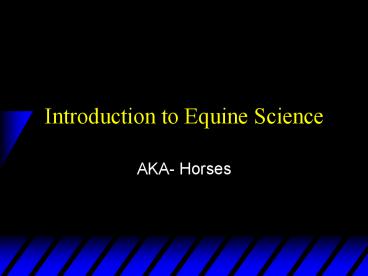Introduction to Equine Science - PowerPoint PPT Presentation
1 / 16
Title:
Introduction to Equine Science
Description:
Training- Train horses for show, competition, or racing ... Horse racing is the biggest spectator sport in the United States. V. Benefits of horses ... – PowerPoint PPT presentation
Number of Views:663
Avg rating:3.0/5.0
Title: Introduction to Equine Science
1
Introduction to Equine Science
- AKA- Horses
2
I. Breeds
3
II. General horse use in U.S.
- 75 are owned for personal pleasure
- 25 are for ranching, racing, breeding, and
commercial riding
4
III. Three main types of horse enterprises
- Breeding- breed mares and sell offspring
- Training- Train horses for show, competition, or
racing - Boarding stables- Facilities for keeping horses
(feed and care)
5
IV. U.S. Economics
- There is over ten million horses in the United
states - Over 16 billion dollars is spent in the horse
industry annually - Horse racing is the biggest spectator sport in
the United States
6
V. Benefits of horses
- Contribute to economic growth
- Provide people with physical exercise
- Provide a release of tensions
- Responsibility
- Family activities (shows, pleasure)
- Competition (rodeos, racing, etc.)
- Work (ranch, farm, hunting, etc.)
- Fun/pleasure
7
VI. Classification by height
- A hand is 4 inches
- Measured from ground to top of withers
- 14-2 hands 58 inches
- Ponies are anything under 14-2 hands
- Horses are anything at or over 14-2 hands
8
VII. General uses of a horse
- pleasure
- breeding
- working stock
- show
- sport
9
VIII. Purchasing a horse
- Breeders
- most reliable
- more expensive
- certified quality
- Private owners
- good or bad, depending on the reason they are
selling the horse - chance to get to know horse and owner
- their guarentee may only be as good as their word
10
- Auctions
- Less reliable
- Hard to know soundness
- Who knows why its there
- Private horse sales a little more reliable
11
IX. What to do when buying
- Find out horses history, pedigree if possible
- Find out how well it is broke and who broke it,
if possible - Age
- Does it have any problems or a history of
problems (lameness, bucking, disease, etc.) - Is it desirable in appearance
12
- Watch it walk and check for soundness in legs
- Ride horse (you may want to have the owner ride
it first) - Check for bridle control, stops, athletic
ability, other qualities that you desire
13
X. Age
- Younger horses usually need more training and a
more experienced rider - Older horses are usually calmer, well broke, and
less experienced riders are needed - Prime of life is 5-12 years old
- Many NFR roping horses are near or in their
twenties
14
XI. Sex of horse
- Mares
- Tend to be moody or flighty, especially when in
heat and in presence of other mares - Geldings
- More dependable and steady
- Stallions
- Hard to manage, especially in presence of a mare
in heat
15
XII. Breed
- Pick a breed that will satisfy your needs
- Quarterhorses- rodeo, stock, racing
- Thoroughbred- racing
- Arabians- endurance
- Paints- color, show
16
(No Transcript)





![book❤️[READ]✔️ Equine Internal Medicine 4th Edition PowerPoint PPT Presentation](https://s3.amazonaws.com/images.powershow.com/10074295.th0.jpg?_=20240708010)
![book❤️[READ]✔️ Equine Internal Medicine 4th Edition PowerPoint PPT Presentation](https://s3.amazonaws.com/images.powershow.com/10074326.th0.jpg?_=20240708013)
























